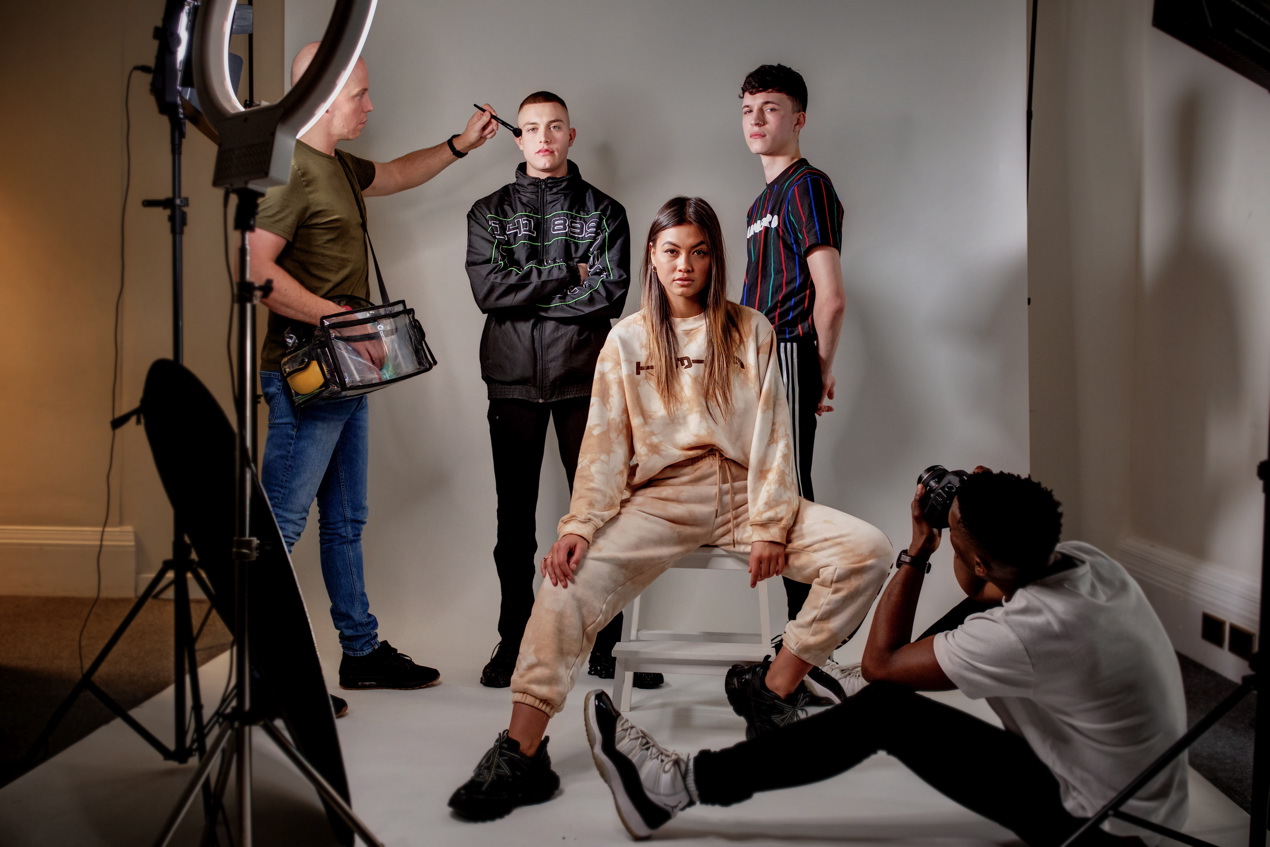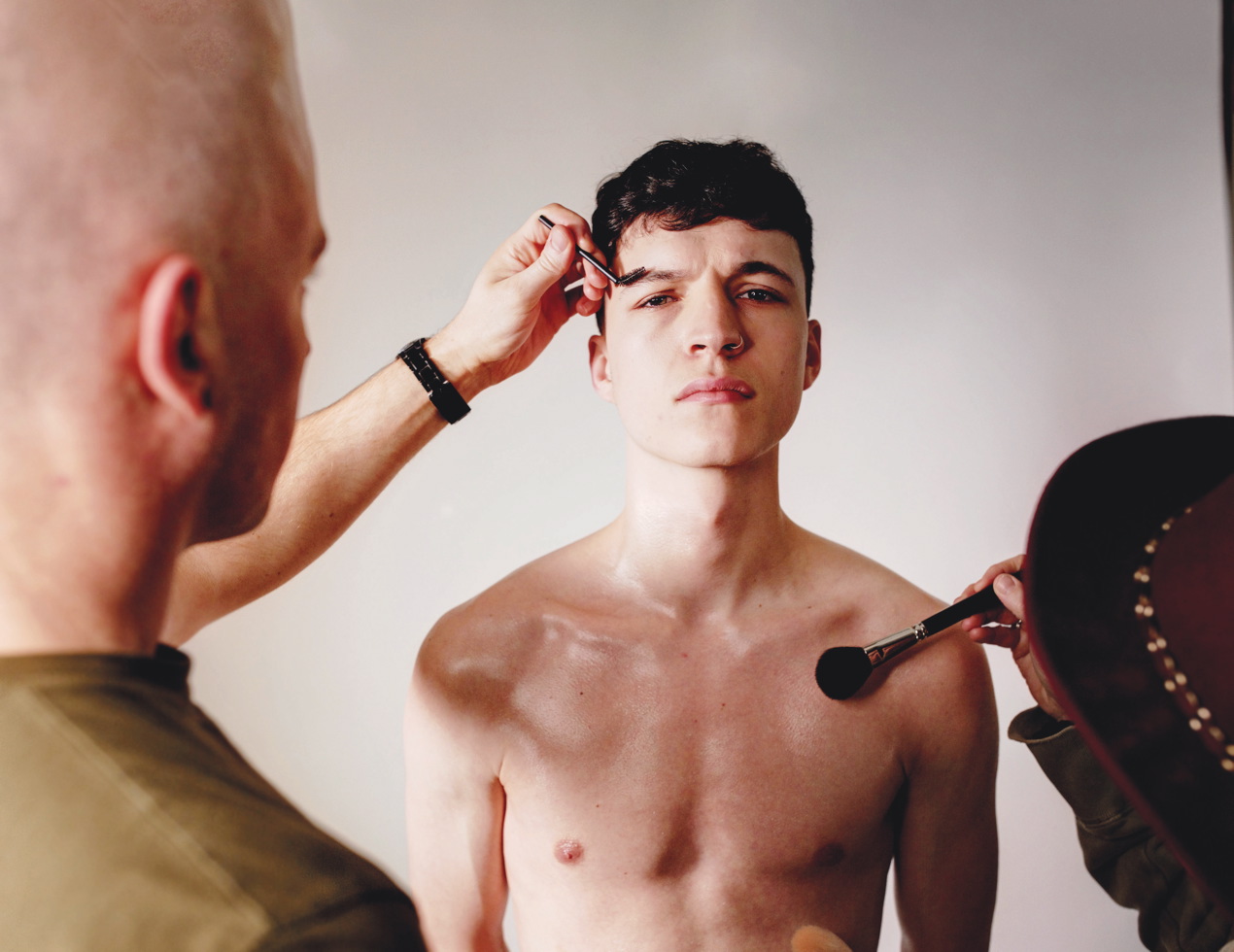Street scene
Ellis Stelfox’s first casting may have been preceded by a kebab but he’s gone on to a successful modelling career. He’s one of the so-called ordinary northerners now in demand by the fashion industry
Traditionally the stomping ground of the chisel-jawed, long-limbed and ethereal, a catwalk might be an unusual place to find a Manchester scally lad. But a sea of change is sweeping over the fashion industry, and one agency in Manchester is being inundated with requests for just that.
Brands want cocksure, cheeky chappies as the new faces of their campaigns – less smouldering David Gandy, more happy-go-lucky with a hint of handsome – and agents from all over the world are flying to the city in search of the next big thing.
“The types of models they used changed to suit what the kids on the street were buying.”
Leading agency Nemesis has a job on its hands. New BBC Three documentary Models: Street to Catwalk follows the agency as it recruits new models for clients such as JD Sports, New Balance, Boohoo and Burberry, and after more than three decades in the industry owner Nigel Martin-Smith knows exactly what he’s looking for.
“I think, without sounding corny, it’s the northern humour, the northern character. In the media it really works,” says Martin-Smith. “It’s that hard-working, optimistic attitude. Back in the day when I started out in the 1980s it was completely different. Models tended to be mainly female. An agency would have maybe 60 girls and 10 or 12 men.
“It was about the shape of them. The girls had to be stupidly thin and the men had to have 30-inch waists and 40-inch chests. The personalities didn’t matter for fashion modelling, but now it’s completely different.”
So what’s changed? What has made a traditionally elitist industry look to the streets for inspiration? Martin-Smith says the rise of e-commerce brands such as Asos and Boohoo have a lot to do with it.
“About three years ago there was a tsunami in the modelling industry because Boohoo exploded,” he says. “Before that there was no fashion industry in Manchester, but there was in London and Milan and Paris and Barcelona, so I used to send models to those cities to work.
“In the past, when people sold clothes in department stores it would take months to filter through to head office what people were buying, whereas now the people selling the fashion can see automatically at the push of a button what people are buying.

“Brands still used traditional models six or seven years ago, but then they saw when they started using bi-racial models or models that were slightly different the clothes were selling fast, so the types of models they used changed to suit what the kids on the street were buying. The people had a lot more influence. Instead of it being fashion designers, photographers or heads of advertising agencies saying this is what a model should look like, all of a sudden it was the people saying this is what a model should look like.
“Now it’s about diversity. Girls can be curve models, they can be petite. It doesn’t matter. It’s about being different and having style and something to say, character and charisma. It’s not about your shape or your height.”
Where do you find normal people with a touch of something special to front high-end ad campaigns? Martin-Smith’s scouts trawl shops and busy city centres looking for talent. It was in Manchester’s Arndale Centre where they came across Jordan Backhouse, a labourer from Salford.
The BBC documentary films Backhouse as he changes out of his hardhat and prepares for castings. During filming his own mother admits she never would have seen him as a model, and maybe Backhouse doesn’t quite believe it himself, drinking cans of Stella on the way to a £750-a-day shoot.
There’s an element of “not quite believing this is real” linking all of the likely lads featured on the show. Twenty-two-year-old Ellis Stelfox was working in a printers when Nemesis signed him to its books.
The camera follows Stelfox as he goes back to Tameside’s Hattersley estate where he grew up, now infamous as the place where Dale Cregan murdered two police officers.
Stelfox’s first casting in London was the first time he’d visited the capital, but his visit was unsuccessful after he ate a kebab immediately before an underwear casting.
“I’d never been to London before. It was somewhere I’d always wanted to go but didn’t really have the money and didn’t really have anything to go down there for,” says Stelfox. “When I went down there it wasn’t what I expected. You hear a load of things about southerners and how they’re rude, but they couldn’t be any more lovely to me.
“I thought I’d be able to walk into it. I thought I could just go down there, be my normal self and I’d just get jobs and it would fall into place, but you have to work hard. That kebab before I went to an underwear casting wasn’t the best idea, but a boy’s got to eat and I was starving, so I just thought I’d have a kebab.”
Stelfox hasn’t had it easy. His mother has suffered with alcoholism and his dad has health problems, but he says family is everything to him, and after a spate of successful shoots he is now aiming high.
“My main ambition is to become rich and famous,” he says. “When I do go modelling it’s like stepping into a completely different world. You don’t know what to expect. It’s all so overwhelming and amazing at the same time. I’m really grateful for the opportunities I get. It’s like a different world but I absolutely love it and to be honest I think it loves me.
“I went to Dublin to do a shoot – that whole experience was crazy. Everything was paid for, the hotel was lovely. I was too excited to sleep. I was just thinking I can’t believe this is my life, being able to do all these amazing things.”
Agencies from as far as China are coming to Manchester specifically looking for the “Manchester look”, which of course is hard to define. The city’s diversity is reflected in the models’ faces. One model, Ethan, boasts an unusual combination of a red afro and striking freckles.
The documentary shows how the agency has high hopes for him, but with a catalogue of convictions Ethan can’t escape his past. He is problematic, but during filming Martin-Smith points out it is his background that makes him so marketable. Without the baggage he wouldn’t be the model clients are so desperately searching for.
Unfortunately Ethan’s criminal background caught up with him and he is no longer working with the agency, but the hunt for big personalities extends to the female models too. Martin-Smith says the days of stick-thin “clothes horses” who have nothing to say are over. Brands want charisma, and they want models to bring their own experiences and personalities to shoots.
It might be why 24-year-old Ruby Wong has been so successful. Wong, from Fazakerley in Liverpool, was juggling three jobs, including one in a burger van, when she was scouted by Nemesis. Within a month of being on the agency’s books Wong was booked up for weeks on end, and she hasn’t stopped since.
“Girls will go online and see Ruby modelling, with all that charisma and looking great and say, I want to be that person,” says Martin-Smith. “Women are all different shapes and sizes – they’re not 5ft 9in, dress size six. Women shopping online don’t want to see girls like that. They’re not selling clothes anymore because real people have finally taken over.”
It’s a reality Wong is still getting used to. She was recently spotted by Next Model Management in Miami. Made famous by hit show America’s Next Top Model, Next is one of the most prestigious agencies in the world. The documentary follows Wong as she flies out to Miami to meet agents, and they love her straight away. They love her “undefinable” ethnicity (she’s half British, half Chinese). They love her Scouse accent. They snap her up, and Wong is currently preparing to fly to the States for three months the moment she can.
She feels she has entered the industry at a time when diversity is celebrated, but she hasn’t always felt confident in her ability to make it.
“When I was younger I used to watch America’s Next Top Model and people used to tell me I should be a model, but I never thought that would be my life,” says Wong. “I really didn’t think highly of myself at all. Modelling has given me a lot of confidence.”
Wong is another Nemesis model who is desperately close to her family. Her mother is a nursing sister in intensive care, and her father works in the mortuary at the same hospital. She has been temporarily separated from them while they work on the frontline in the battle against Covid-19, and Wong says she is apprehensive about the prospect of leaving them for longer as her career takes off.
“I’m really close to my mum and dad,” she says. “We do everything together. The thought of being away for [a long period] of time is making me nervous, but we’ve already made a plan. I’m just going to keep flying them out.”
Wong admits her lifestyle has drastically changed since the days not too long ago when she was working in a burger van, but it’s not just the financial aspect that has changed her life for the better.
“I feel empowered on shoots,” she says. “I didn’t think this industry was as nice as it is. I’ve made a lot of friends doing this job. I doubted myself so much over the years and it was so silly to do – to sit there and not allow myself to dream. Modelling has opened so many doors for me. I feel extremely lucky.”
Models: Street to Catwalk is available now on BBC iPlayer
